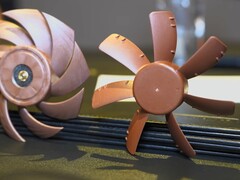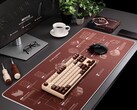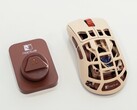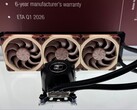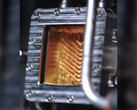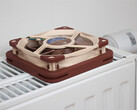Blade angle and angle of attack are distinct but often confused
Dellinger clarifies that “blade angle” (or stagger angle) refers to the geometric tilt between the fan blade and the plane of rotation, while “angle of attack” describes the aerodynamic interaction between the blade and incoming airflow. These angles vary across the blade length—steeper near the hub and flatter at the tip—to match the rotational velocity profile. A larger blade angle increases airflow per rotation but risks stalling, leading to flow separation and increased acoustic turbulence. Even small adjustments in blade angle, as little as 1°, can measurably impact both airflow performance and noise output.
Fewer blades can reduce noise, but at a design cost
Fan blade count directly affects blade passing frequency, which correlates with how humans perceive fan noise. For example, a seven-blade fan spinning at 2000RPM emits a lower-frequency 233Hz tone compared to a nine-blade design’s 300Hz. However, reducing blade count introduces trade-offs in pressure generation and blade stiffness. Designers must compensate with larger blades or higher RPMs, which can negate the acoustic benefit. Noctua currently favours nine-blade designs for 120mm fans, citing them as a balance between airflow, pressure, structural integrity, and acoustics.
Heatsink fin density influences turbulence and tone
Heat sink design affects not just cooling performance but also fan noise behaviour. While heatsinks benefit from more fins and greater surface area, increasing fin density introduces airflow resistance. This resistance can force fans to operate near stall regions on their pressure curves, increasing turbulence and tonal unpleasantness. Heat transfer is also uneven along a fin—peaking at the leading edge and falling off due to boundary layer formation. Noctua’s recent designs attempt to pair fan characteristics with matched heatsink resistance to stay within optimal airflow ranges.
Design advancements likely to come from materials, not geometry
While simulation and prediction tools have matured, future improvements in consumer fan design may depend more on materials than geometry. Noctua’s transition from PBT and ABS plastics to liquid crystal polymer (LCP) enabled tighter tip tolerances and lower vibration, which helped stabilize performance at higher speeds. Metal or composite blades could theoretically offer benefits, but would likely raise noise and manufacturing costs. Some acoustic tuning is already being done through controlled turbulence techniques, such as the centrifugal turbulator hub structure seen in Noctua’s G2 fans.
Conclusion
Dellinger remains cautious about future breakthroughs in fan design, suggesting that most engineering possibilities have been explored within the constraints of current materials and use cases. While low blade count or finless concepts may attract interest, practical limitations in airflow, turbulence, and cost keep them largely theoretical for now.




